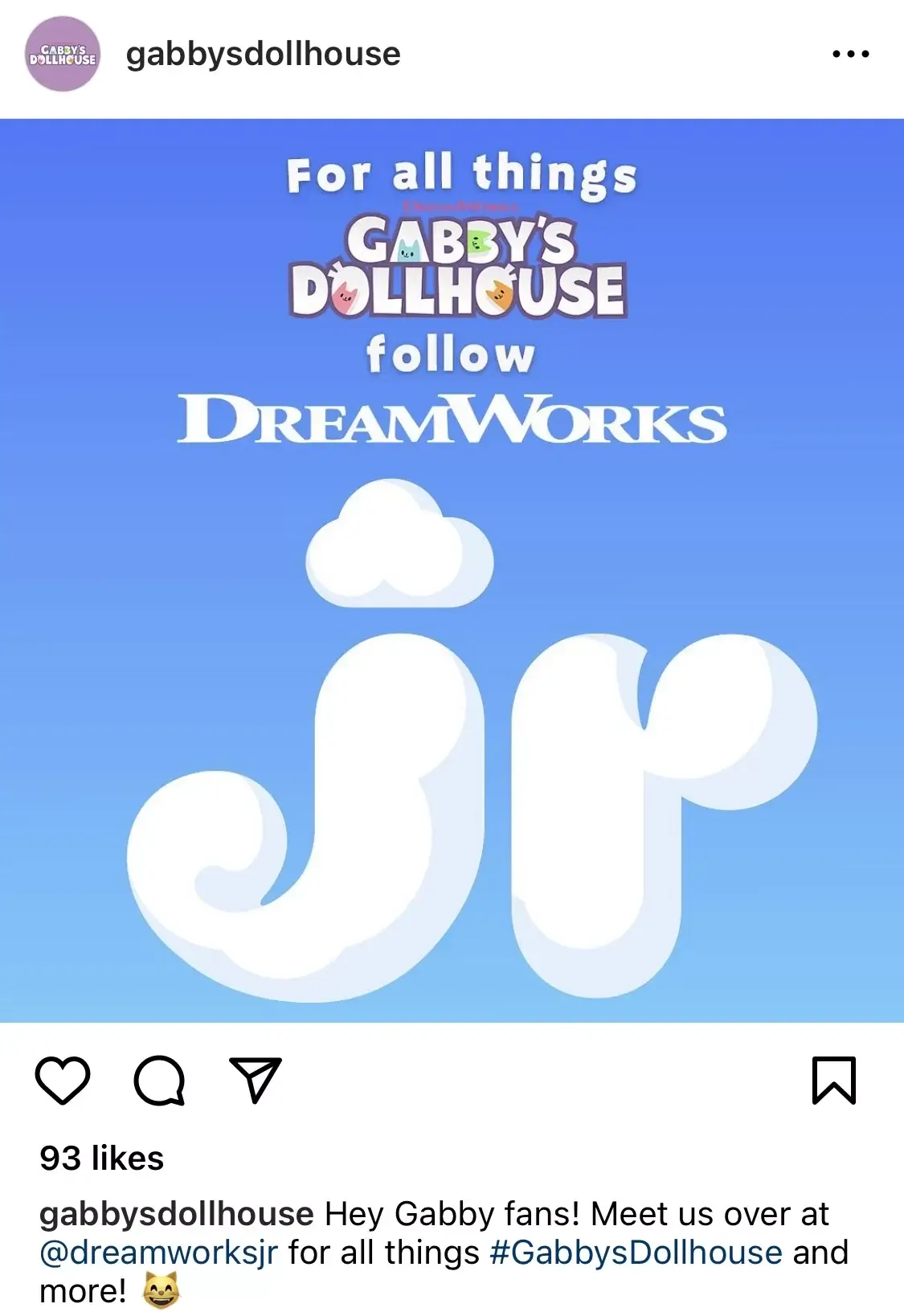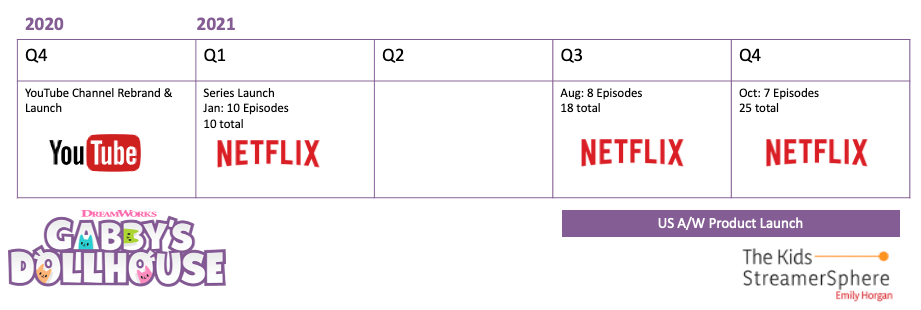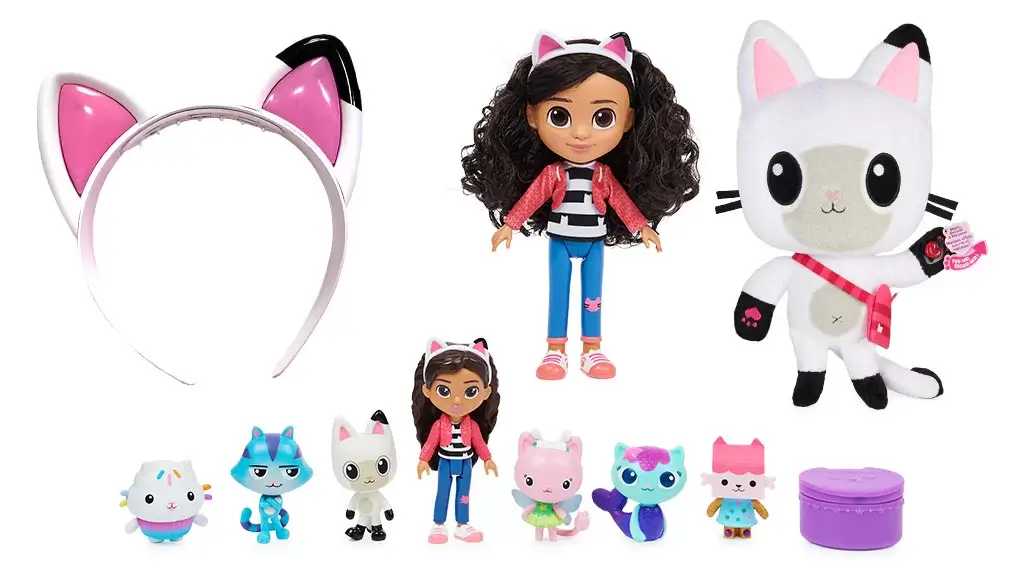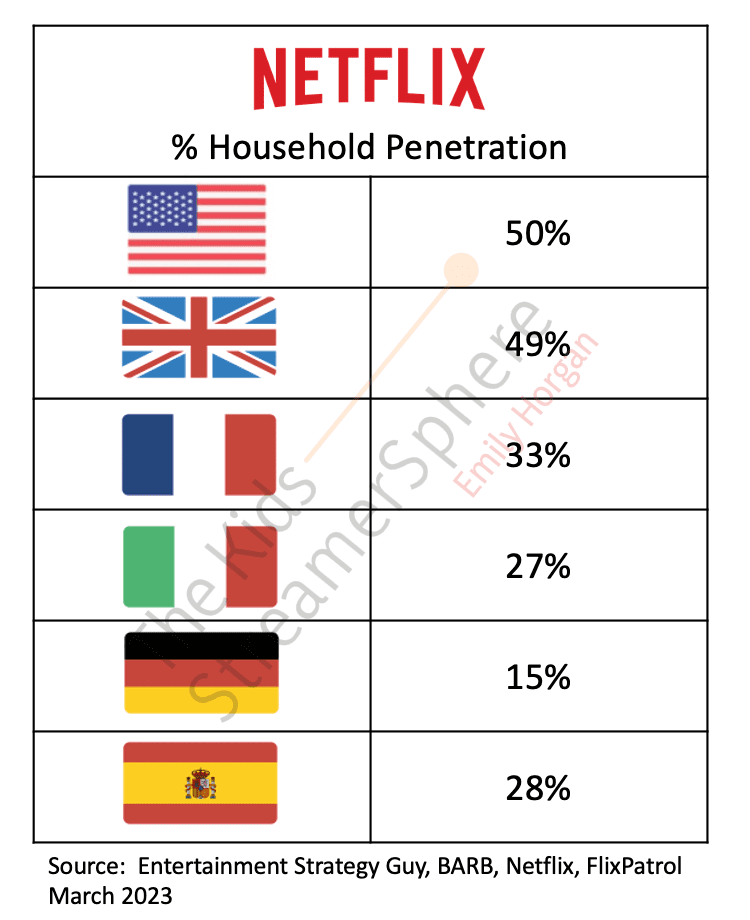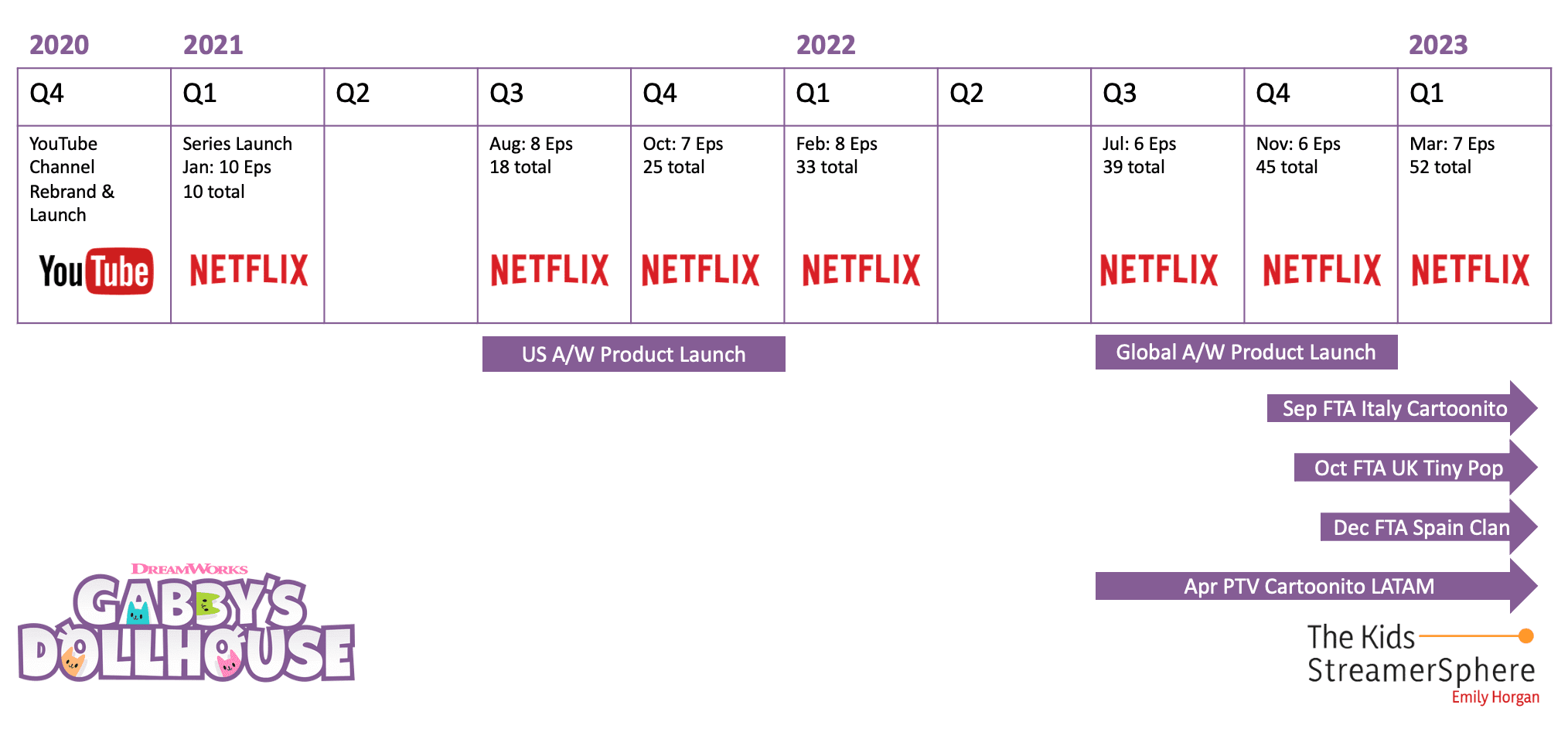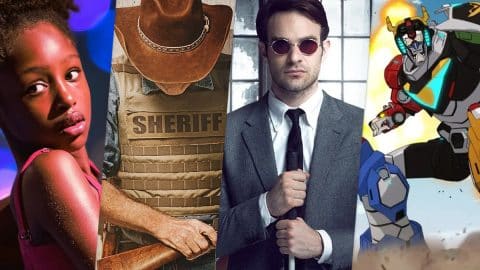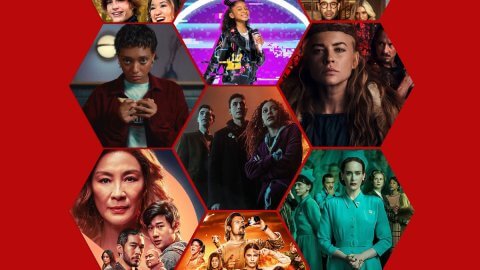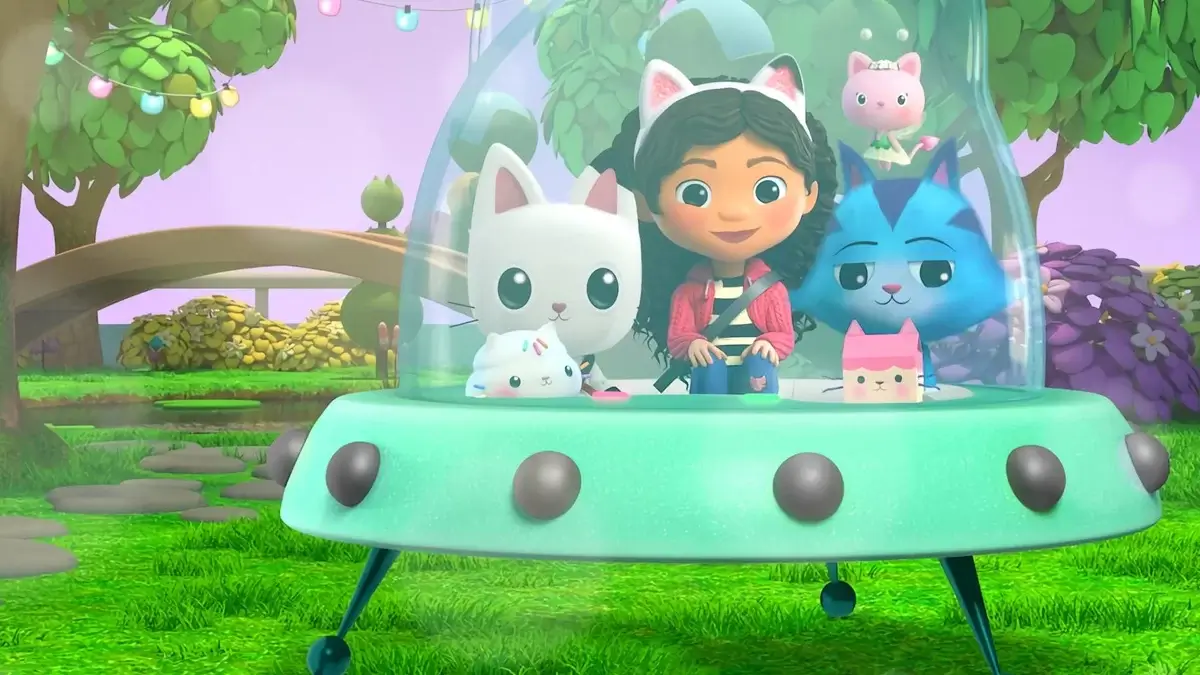
This time last year, I mused on behalf of What’s on Netflix about whether Gabby’s Dollhouse could be DreamWorks’ next big kids franchise. Key performance indicators, specifically in the US, showed the show was gaining crucial momentum.
Fast forward 12 months and Gabby has undeniably claimed its place alongside Bluey and CoComelon as one of the top kids IPs on everyone’s lips. The most notable thing about Gabby, though, is that it’s a true streaming-led franchise—originating on a streaming platform, holding no pre-established affinity among today’s audiences.
This is difficult to achieve. As Margie Cohn, president of DreamWorks Animation, told The Hollywood Reporter:
“Series like Gabby’s Dollhouse are few and far between, especially in this highly competitive and crowded television landscape… The most popular properties today are still the ones that broke out five or even 10 or more years ago.”
One thing people sometimes forget, however, is that DreamWorks have a track record in this area. Spirit Riding Free is arguably the only other IP to hit franchise-level success out of streaming. I’ve been tracking Gabby closely since she launched. Here are a few strategies I’ve seen that will have undoubtedly contributed to her success.
1. Pre-gaming a YouTube presence
Although Gabby’s Dollhouse launched on Netflix in January 2021, the show had actually been active on YouTube from the previous year. Smartly, it had taken over and rebranded a presence originally built by DreamWorks’ Rhyme Time Town. This meant that precious YouTube algo juice wasn’t at a standing start and Gabby could build on an already established preschool audience. Nice for her!
YouTube is a fundamentally central facet of building a kids brand today. If my back was against the wall, I’d say (with a wince) that it’s more important than free-to-air from a distribution point of view. One of the key questions for IP owners is where do you start with a YouTube presence? There’s the option to go with those belonging to your partner platforms. The Netflix Jr. YouTube channel, for example, comes with nearly 14 million subscribers. That level of guaranteed viewership is a definite plus, but if it’s your only approach, it also completely gives away control of your destiny.
So if you’re launching a brand on YouTube, where do you start? If you own the rights to multiple IPs, there can be potential in building a “hub” channel: a presence servicing multiple brands, which builds an audience agnostic of a specific show. There are many kids producers who do this, including two main YouTube operators, WildBrain and Little Dot Studios.
Without that luxury, what are your options? If you want to jump-start success, you can market your way there through YouTube ad spend on Search and TrueView (pre-roll ads). How much the algorithm deserts you once you stop feeding it money is another question.
A less obvious approach is purchasing a channel second-hand. This follows a similar vein to Gabby in that it involves a rebrand of a pre-existing asset, in the hope of pulling in and converting that audience. Cost here will be scalable in line with how big a channel you want to buy, assuming the right one in terms of size and audience is on the market.
2. Focusing on the kids, not the parents
One thing you’ll notice about Gabby’s Dollhouse is that investment to build owned adult-facing social media channels hasn’t been prioritized. There must have been consideration given to this, since Instagram, Facebook and Twitter handles were set up in 2018. Pages have a nominal following, likely all organic, and now throw to DreamWorks Jr.’s social presence. This is more established, although still relatively modest, with 80k likes on Facebook and 21k followers on Instagram.
Social media can feel like a really important marketing tool, given all of us (old people) are on it constantly. Its application in marketing to young kids and preschoolers should be finely tuned, though. They’re not on there, they shouldn’t be, so if you want to get them to watch your show, think twice before overinvesting in this type of marketing. Parents are on there, which is helpful in some ways, particularly when promoting toys and other merchandise.
And this is where you can see the Gabby’s Dollhouse social media footprint. There are plenty of sponsored influencer posts linking product and local retailers. There’s also cake. Lots and lots of cake, which is the slam dunk grammable opportunity for this property.
3. Rolling out episodes on Netflix just so
First window episode roll-out for a preschool franchise is a tricky tango, a challenging cha-cha, a bruising boogaloo. (Too far? Never.) On one side, you’re weighing up episode delivery and dubbing, which, no matter what, are always running late. On the other, you’re trying to ensure the audience are getting enough episodes to drive stickiness at launch, whilst still holding content to keep you going throughout the year. Add to this an overlay of consumer product expectations, with licensees gagging for FTA holdbacks to pass, and jittery about multi-million-dollar minimum guarantees, and the balance you need to tread is knife edge.
All this assumes you have any sort of say and can dictate content programming to support your brand. As far as I know, dictating content launch dates to Netflix (or platforms in general) isn’t exactly A THING, but if anyone could have a chance at influence, you’d think it would be DreamWorks.
For Gabby’s Dollhouse, Netflix episode roll-out landed just so:
I’m not saying there wasn’t a Hail Mary moment in the eight months between season 1 in January and season 2 in August. Sensible prayers would have taken the form of content marketing initiatives to keep new viewers finding the series. By Christmas 2021 there was a decent volume of episodes, plus some nice content momentum to support a successful US toy launch. Don’t take my word for it, though, ask Nielsen Streaming Content Ratings. Gabby’s Dollhouse would finish up 2021 as the top streaming Original for kids 2 – 11. It beat out other DreamWorks series based on established IP like Jurassic World: Camp Cretaceous and The Boss Baby: Back in Business. It even trumped Bluey and PJ Masks, this all despite only having 10 episodes of content available for most of the year.
4. Targeting US product launch a season after content launch
Timing-wise, what the year one roll-out of Gabby’s Dollhouse content managed to do was deliver the perfect run-up to Spin Master’s US toy line launch for autumn/winter 2021. The show had time to bed in with viewers, buoyed by its in-depth YouTube presence, and we’d presume content marketing.
New episodes for back to school and again ahead of holidays gave lots to shout about content-wise in the key gifting season. US product and retail marketing would have flighted alongside this, amplifying noise. The episode drops would also ensure the series was “above the fold” on the Netflix homepage over this period. The “New Release” content rail on Netflix’s viewing platform is probably the only place you can be assured your show will land.
5. Toyetic consumer product hooks to die for
The clue is in the name, Gabby’s Dollhouse. The themes in this show are so consumer product native, it hurts. Beyond the dollhouse, it’s the cats! Cute and eye-catching in either plush or play set. A cat ear hair band as an accessory writes itself, and also provides a low entry price point for even a casual viewer to have their own physical piece of the show. Add to this the crafting and baking and you have multiple angles for authentic, exciting consumer product themes across multiple categories. Honestly, the creative product hooks in this show deserve a Just Make Sense list of their own.
6. Doubling down on global linear distribution beyond Netflix
Like any true conquistadora, the battle cry for Gabby was “First the US, then the world!”, as 2022 would see the property expand. Netflix penetration globally isn’t as strong as in the US. My last tally has the % households as below for key European markets, give or take up to 33% of alleged password sharers:
Potentially strong enough in the UK, but much weaker across other countries. The natural flipside of #streamingwars is the argument that linear TV is dead. Linear TV has clearly undergone a huge transformation in the last decade. There has been some significant shuttering for (close to heart) kids channels specifically. Not all of this has been down to changes in viewership and audience behaviour. Some of it will have been motivated by big entertainment companies like Disney needing to be free of content commitments with major distributors like Sky. These companies would not be able to feed their streaming services with such distribution commitments in place. The thing is, linear TV is not dead. Particularly not in Europe and particularly not for preschool content. The trust it holds with parents remains intact.
The team behind Gabby’s Dollhouse got this and didn’t hold back signing up key free-to-air kids partners in Italy, the UK and Spain. These assured broad reach among kids in these markets across back to school and Christmas 2022. They also signed a pay-TV deal with Cartoonito in LATAM, which came into effect earlier. The lower audience reach delivered by pay TV may have been the reason they opted to launch dedicated Gabby LATAM YouTube channels at the end of last year.
This is also where you can see the just so factor for the Gabby’s Dollhouse episode roll-out for year 1. Eighteen episodes out by August 2021 allows an assumed 12-month holdback for these to hit partners beyond Netflix in the following back to school, with more volumes just around the corner in October.
7. Holding back global product launch for another year after the US
All of this activity was priming for the upcoming global product launch in Autumn/Winter 2022. It may have been tempting for the DreamWorks team to align product roll-out across the US and globally. There are operational benefits, marketing materials are more easily recycled for example. The risk with this strategy was that content distribution in markets outside the US was unlikely to be at critical mass. By holding back product launch for another 12 months, DreamWorks, and master licensee Spin Master, could have confidence that the volume of viewers for Gabby’s Dollhouse was enough to drive toy sales. Heck, in the UK they even needed to bring forward product roll-out, with Smyths Toys launching the range in June.
8. Theming up later consumer product lines, as it’s doing for season 7!
The thing about running ongoing consumer product lines is that there’s always a need for “fresh”. Products need new hooks and angles. This is why introducing water-themed product for season 7, right in time for Spring/Summer 2023, well, just makes sense. I would expect to see an abundance of Gabby and Mercat toys coming to a pool near you this summer.
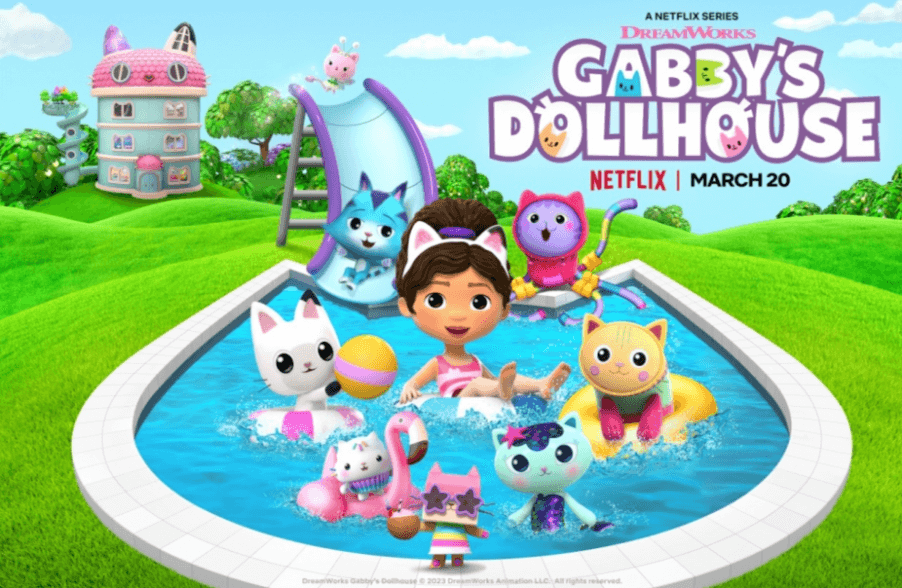
New themes for consumer products can be driven either by content or toy. Driven by content is things like new characters. Driven by toy is usually things like play patterns or seasonality. In my opinion, the best products are driven by both, as they are in this case. If you heard that Gabby’s Dollhouse was going for a swimming pool theme, you’d probably imagine something along the lines of the above image: Gabby and the kitties in a pool, having fun. It exists without the need for content but can be underscored and expanded by inclusion in the series, as season 7 has done. The whole season isn’t fully dedicated to this, though; there are other toyetic elements you can easily see coming out for future consumer product lines, like fairies. Co-creator Traci Paige Johnson gives excellent insights about getting the right balance for consumer product integrations for content in this interview.
9. Building, building, building, building
Achievement metrics for Gabby’s Dollhouse keeps stacking up. Over 700M views clocked across the three Gabby’s Dollhouse YouTube channels. Nearly 60M streams for “Gabby’s Spotify” playlist. In terms of content performance, unfortunately season 7 failed to make it into the Netflix Global Hours Viewed Top 10ut this is a tricky place for kids content. It fragments out individual seasons which doesn’t really scan with how preschoolers consume tv series. For this specific audience only four shows have ever made it through: CoComelon (multiple seasons), Little Angel (launch), The Creature Cases (launch) and Gabby’s Dollhouse (season 2 but no others). So it’s a major achievement to make it, rather than a major red flag if you don’t.
What we know from Nielsen Streaming Content Ratings is that average weekly minutes viewed in the US went from 170M in 2021 to 180M in 2022. The show popped into this Top 10 across two weeks recently in February, up again at 265M and 290M. Straight off the press, just released this week, we can see that Gabby’s Dollhouse season 7 drove overall viewing of the programme up to 383M minutes viewed. Gabby is no longer a franchise-in-waiting, it would seem that the full franchise flywheel force is in operation.
10. And all the things we can’t see…
There is a rake load of other things going on for Gabby’s Dollhouse that I haven’t captured here. For example, in many of the articles linked you can see the PR team at work. Add to these consumer marketing, promotions, retailer activations, retail marketing, great publishing partners, multiple apps, the soundtrack and more. There’s no doubt that this is now a full-scope 360-degree franchise.
So what’s next for Gabby? This time last year, another 20-episode order was announced. You’d have to think there would be more of those coming. Bluey made the franchise statement of having a float at the Macy’s Thanksgiving Day parade last year. The sky seems to be the limit for Gabby too so could she get in on the action for 2023?
I was recently asked whether there was one unique or groundbreaking thing about the Gabby’s Dollhouse franchise strategy that made the whole thing work. My view, kind of annoying, is that the one specific thing DreamWorks did is all of these things. Add in a smattering of patience and fortitude. Plan the plan, trust the plan, do the plan. Don’t get distracted by early success and mess with the plan. Anyone working in corporate knows that’s a tough feat to pull off: alignment, management, and execution.
While smart commentators in the entertainment industry are struggling to think of a new entertainment franchise that’s gathering momentum, we’re just over here in the kids space celebrating one which is doing just that, and it’s streaming originated to boot!

